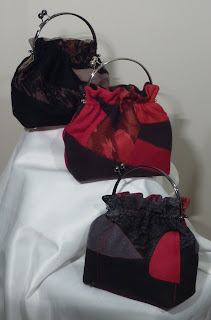I've finally had time to work on and complete my 2nd PAP that I last blogged on in
May. The photos below show the front, back and side views of the wearable.
When I last blogged about this I had begun work on the bodice. After some suggestions from Sian I adjusted the neckline to follow the shape of the head a little more and developed the straps to link in with the metallic bust on the back.
The face on the metal shim is drawn free motion without thread in the needle (not too clear in this photo) which unfortunately appeared a little more solid in shape than I had intended, but still gives an interesting contrast to the sheer faces. This leads down to the central back panel -
which includes faces cut from sheers and printed on dyed scrim with metal shim and embroidered highlights.
My original intention was to focus on metallic lace in the piece so I added 4 shaped lace panels to the bottom of the bodice that incorporated the metal shim shapes in the bodice sides and schematic faces prepared from embroidered sheer.
The lace followed the width of the side panels as did the cream silk overlays underneath. The cream was used to show off the darker metallic lace and dark sheer. The long edges were roll overlocked for neatness and the lower edges were trimmed also in shim and metallic lace.
The metal shim shapes are the same but half size. The lace was made first and then added to the silk, cutting the surplus silk away close to the stitching line. The bottom of the main skirt fabric was shaped by embroidering the same shape around the edge then removing surplus fabric with a soldering iron since this fabric was synthetic.
This edging alone I felt looked too
rounded when compared to the 'spiky' edges of the metallic lace above so the underskirt, a grey chiffon, was edged completely in metallic lace. This was done deliberately rather unevenly so that in sections of the hem the lace could be seen more than other sections, bordering the skirt shapes like the shim in the shim lace pieces.
More of the shapes were embroidered and cut out in the central lower edge to add interest and reveal the chiffon layer underneath.
Timing involved in this PAP:
Design work for this piece started in August 2011 and was completed April 2012 (covering 20 hours)
Sampling and embroidery work started Feb 2011 and completed June 2012 (covering 55 hours)
Costing involved in this PAP:
Fabrics
1m silk dupion
3m polyester chiffon
1m silk georgette
1m cotton
0.5m polyester organza sheer
0.25m scrim
105
0.5m batting
0.5m Vliesofix
1m watersoluble fabric
25
metallic threads and other sewing threads (5 reels)
25
2m x 60cm 0.004"copper metal shim
50
Miscellaneous (liver of Sulphur gel, bicarbonate, mordant for natural dyeing, eyelets, printing ink, machine needles!)
15
Total 220 AUD
Self Evaluation of PAP:
Metal shim is not something I'd like to work with every day, but I did enjoy the challenge and the result. My development samples along the way were very useful and tested out most of my ideas, marked the boundaries and gave me confidence to tackle the finished larger piece successfully. Once you make a hole in the metal you can't go back!
Some things I may have done differently eg. made the head in the central back of bodice less solid and 'blocky', perhaps used a darker coloured underskirt to highlight the cutwork in the skirt, but overall I am pleased with the result of a wearable piece that I can actually wear!


















































